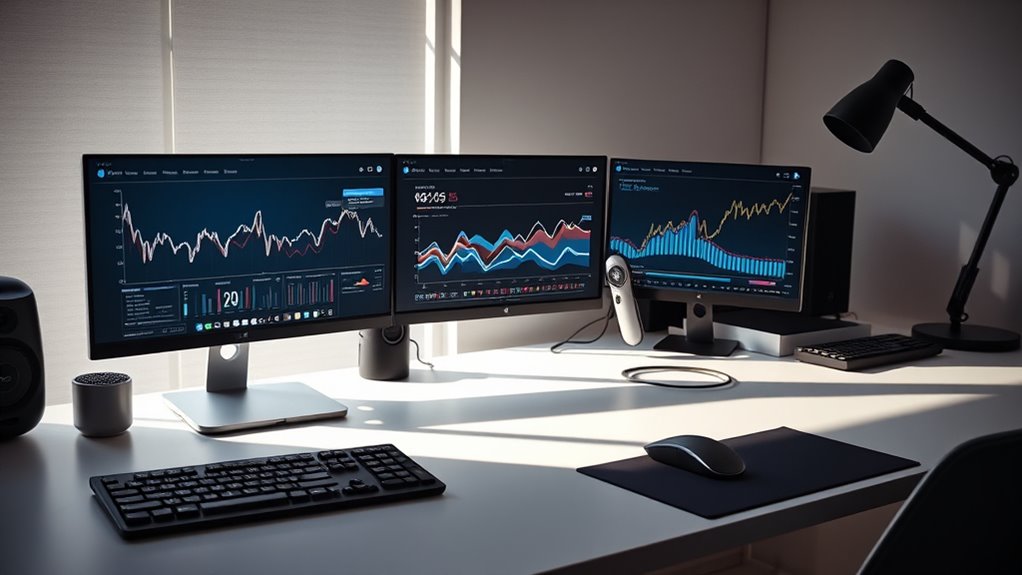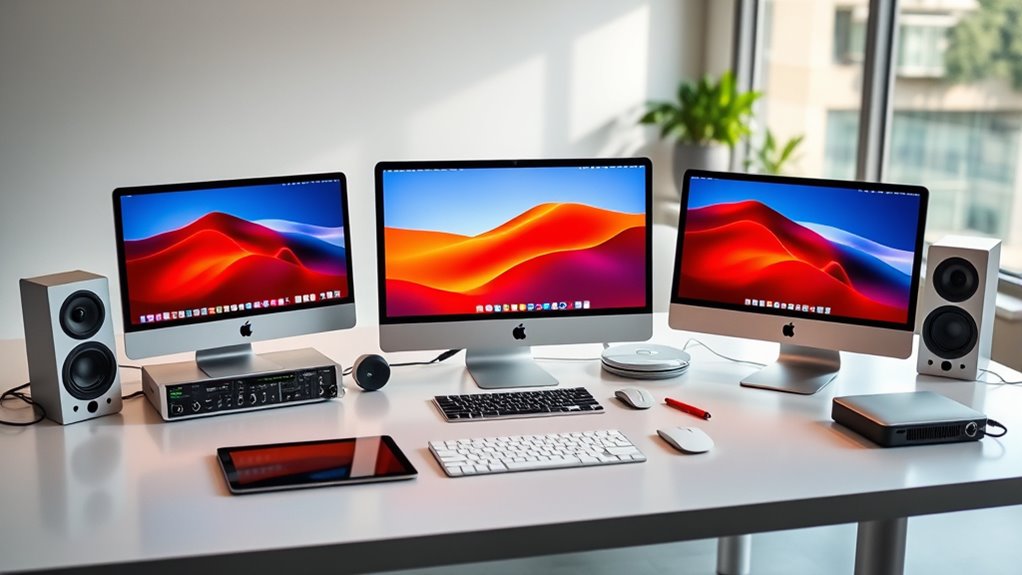For top power and performance in 2025, I recommend the high-end Mac Studio configurations with the latest M4 chip, maximum RAM (up to 64GB), and ample storage—think 4TB or more for demanding workflows. These models excel at heavy multitasking, 3D rendering, and editing tasks, offering future-proofing that keeps pace with evolving needs. Stick around, and I’ll share more options to help you choose the best setup for your goals.
Key Takeaways
- Opt for the highest-spec M4 chip with 10 cores and 64GB RAM for demanding professional workflows.
- Choose configurations with 8TB storage and advanced GPU options for maximum performance and future-proofing.
- Prioritize models with multiple Thunderbolt 4 ports and HDMI for extensive peripheral and display compatibility.
- Consider larger storage and RAM options to ensure longevity and handle evolving software and project demands.
- Balance budget and needs by selecting top-tier configurations for optimal power, performance, and long-term value.
Apple 2024 Mac mini Desktop Computer with M4 Chip
If you’re looking for a compact desktop that packs serious power, the Apple 2024 Mac mini with M4 chip is an excellent choice. Its small 5×5-inch footprint, just 2 inches thick, makes it perfect for tight spaces, yet it delivers impressive performance. Equipped with a 10-core CPU, 10-core GPU, and a 16-core Neural Engine, it handles multitasking, video editing, and creative workflows effortlessly. With 24GB of unified memory and a fast SSD, apps open instantly, and workflows stay smooth. Plus, its quiet operation and modern design fit seamlessly into any workspace, making it a reliable, powerful, and space-efficient desktop option.
Best For: users seeking a compact, powerful desktop for creative tasks, multitasking, and everyday computing in small spaces.
Pros:
- Small, sleek design that fits easily on any desk or workspace
- Powerful M4 chip with high-performance CPU and GPU for multitasking and creative workflows
- Quiet operation and efficient power consumption make it ideal for extended use
Cons:
- Limited internal storage options may require external drives or cloud storage
- Only three ports, which might necessitate additional adapters for expandability
- Slight initial setup challenges and small SSD capacity could be a concern for some users
Apple Mac mini Desktop Computer with M4 Chip (256GB SSD, 16GB RAM)
The Apple Mac mini with M4 chip is an excellent choice for professionals who need powerful performance in a compact, space-saving design. Its small footprint measures just 5 by 5 inches and weighs only 1.5 pounds, making it easy to place anywhere. Powered by the 10-core M4 chip, it delivers impressive speed with hardware-accelerated ray tracing, a Neural Engine, and media engines for seamless video editing. With 16GB of unified RAM and a 256GB SSD, it handles multitasking and storage efficiently. Connectivity options include Thunderbolt 4, USB-C, HDMI, and Ethernet, ensuring versatile compatibility. It’s a compact powerhouse perfect for demanding workflows.
Best For: professionals and creatives seeking a compact yet powerful desktop computer for multitasking, video editing, and demanding workflows.
Pros:
- Extremely small and lightweight design, easily fitting anywhere
- Powerful M4 chip with 10-core CPU and GPU for fast performance
- Versatile connectivity options including Thunderbolt 4, HDMI, and Ethernet
Cons:
- Limited storage starting at 256GB, which may require external solutions for large files
- No dedicated graphics card, potentially limiting high-end gaming or intensive graphics tasks
- Higher configurations (like 32GB RAM) require additional cost and planning
Apple Mac mini Desktop Computer with M4 Chip, 16GB RAM, 512GB SSD
For professionals seeking a compact yet powerful desktop solution, the Apple Mac mini with the M4 chip stands out as an ideal choice. Its 10-core CPU and GPU deliver lightning-fast performance, perfect for demanding tasks. With 16GB of unified memory and a 512GB SSD, it handles multitasking and large files effortlessly. Its small footprint—just 5×5 inches—makes it easy to fit next to your monitor or anywhere in your workspace. Equipped with multiple ports, including Thunderbolt, HDMI, and Gigabit Ethernet, it offers excellent connectivity. Seamlessly integrated with Apple’s ecosystem, it enhances productivity while prioritizing privacy and security.
Best For: professionals and creative users seeking a compact, high-performance desktop that seamlessly integrates with Apple devices and offers robust multitasking capabilities.
Pros:
- Powerful M4 chip with 10-core CPU and GPU delivers lightning-fast performance.
- Compact 5×5 inch design easily fits into any workspace.
- Extensive connectivity options including Thunderbolt, HDMI, and Gigabit Ethernet.
Cons:
- Limited to macOS, which may not suit all software preferences.
- No upgrade options for RAM or storage post-purchase.
- May be considered costly compared to other mini desktop solutions with similar specs.
Factors to Consider When Choosing Mac Studio Configurations

When choosing a Mac Studio configuration, I consider my performance needs first to guarantee it handles my workload efficiently. I also look at storage, memory, and connectivity options to match my specific tasks, while keeping size and space limitations in mind. Budget is another key factor that helps me find a balance between power and affordability.
Performance Needs Assessment
Evaluating your typical workload is essential to choosing the right Mac Studio configuration. If you handle demanding tasks like 3D rendering, video editing, or gaming, a multi-core CPU like the 10-core M4 chip can provide the necessary power for smooth multitasking. Consider whether hardware-accelerated ray tracing or a high-performance GPU is vital for your workflow. For everyday use or moderate multitasking, 16GB of memory might be enough, but professionals working with large files or intense applications should consider 24GB or 32GB. Also, assess your storage needs carefully—whether 256GB, 512GB, or more—based on how many files and applications you regularly use. Matching your performance requirements with the Mac Studio’s capabilities helps prevent overinvesting and ensures efficient operation.
Storage and Memory Options
Choosing the right storage and memory options can considerably impact your Mac Studio’s performance and longevity. Larger memory options, like 32GB or 64GB, boost multitasking and help demanding applications run smoothly. Storage capacity varies from 256GB to 8TB, with higher options ideal for large media files or professional workflows. Upgrading RAM and SSD at purchase can enhance efficiency and extend your device’s lifespan, especially if you work with resource-intensive tasks. Keep in mind, configurations with more RAM and larger storage come at a higher initial cost but offer better future-proofing. Your specific use case—whether video editing, 3D rendering, or general productivity—should guide your choices. Investing thoughtfully ensures your Mac Studio remains powerful and capable over time.
Connectivity Requirements
Selecting the right Mac Studio configuration requires careful attention to its connectivity options, especially if you plan to connect multiple peripherals or high-resolution displays. I look for enough Thunderbolt 4 or USB-C ports to support several high-res monitors and external devices simultaneously. It’s vital these ports support fast data transfer speeds, like 10Gb/s or higher, for seamless movement of large files or backups. An HDMI port compatible with HDR or 4K/8K resolutions is also essential for my display needs. Additionally, I check if the Ethernet port supports my required network speeds for reliable wired internet. Finally, I consider extra ports like headphone jacks or SD card slots, making sure they’re available if my workflow demands them. These factors ensure robust connectivity tailored to my professional setup.
Size and Space Constraints
Since space on my desk is limited, I need to carefully consider the physical size of the Mac Studio to make certain it fits comfortably alongside my other peripherals. The Mac Studio’s compact form factor usually fits on most desks, but I still measure my available space to ensure it doesn’t block other devices or workspace elements. I also pay attention to ventilation and airflow, as a smaller area might need extra clearance to prevent overheating. I evaluate my setup to see if the Mac Studio can be positioned ideally relative to my monitors, accessories, and power sources. Additionally, if I opt for larger configurations with extra hardware or accessories, I’ll need more space, which could influence my choice of model size.
Budget Considerations
Budget considerations play a crucial role in determining which Mac Studio configuration I can afford, especially since higher-end models come with increased RAM and larger SSD options that drive up the price. If I have a limited budget, I might need to settle for a base model with lower storage and RAM, which could affect performance during demanding tasks. However, investing in a more expensive configuration can be worthwhile for better future-proofing, as it can handle software updates and increased workloads more effectively. The cost difference between options can be significant, so balancing current needs with long-term plans is essential. Choosing a configuration with expandable storage or additional RAM might mean higher upfront costs but can save money later by avoiding external upgrades.
Frequently Asked Questions
How Does the M4 Chip Compare to Previous Mac Processors?
The M4 chip outperforms previous Mac processors considerably, offering faster speeds and better energy efficiency. I’ve noticed smoother multitasking and quicker rendering times with it, thanks to its advanced architecture. Compared to earlier models like the M1 and M2, the M4 provides a notable boost in performance, making it ideal for demanding tasks. If you’re considering an upgrade, the M4 is a game-changer for power and productivity.
What Are the Upgrade Options for Future-Proofing Mac Studio?
If you want to future-proof your Mac Studio, I recommend opting for the highest specs available now, like the latest M4 chip, maximum RAM, and ample storage. Keep an eye out for upcoming hardware updates from Apple, and consider modular upgrades if possible. Staying flexible with your configurations guarantees you’ll get the most longevity out of your setup, adapting easily to new software demands and creative needs.
Can the Mac Mini Handle Professional-Grade Video Editing Tasks?
Can the Mac mini handle professional-grade video editing? Absolutely, but it depends on your needs. I’ve found that the latest Mac mini with M2 or M2 Pro chips can smoothly handle 4K editing and complex projects, especially if you upgrade its RAM and storage. However, for heavy 8K workflows or large-scale productions, a Mac Studio might be a better choice. Are you willing to compromise on some power for a smaller form factor?
How Important Is RAM Size for High-End Creative Workflows?
RAM size is vital for high-end creative workflows because it directly impacts how smoothly I can run multiple demanding applications simultaneously. More RAM allows me to handle large files, complex edits, and multitasking without slowing down. I’ve learned that upgrading to ample RAM guarantees my workflow stays efficient, reduces rendering times, and prevents crashes. For serious creative work, I always prioritize having enough RAM to keep my productivity high.
What External Peripherals Are Recommended for Optimal Performance?
For optimal performance, I recommend investing in a high-quality external monitor with accurate color reproduction, a fast external SSD for quick data access, and a reliable audio interface if you’re into sound editing. Additionally, a good keyboard and mouse or trackpad boost productivity. I also find that a USB-C hub helps connect multiple devices seamlessly. These peripherals streamline my workflow and guarantee I get the most out of my Mac Studio.
Conclusion
So, after all this, it’s funny how the perfect Mac Studio setup might just come down to what I *think* I need versus what I actually do. Sometimes, chasing the top specs feels like a never-ending game of “more is better,” but honestly, the right configuration is the one that fits your workflow, not the hype. Ironically, the best power and performance often come from knowing when to stop and just get to work.











